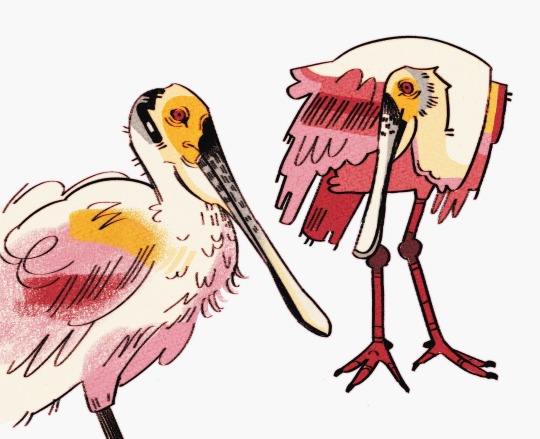Text
It was a rough day outside but tonight is even colder. I hope they all have a safe spot for the night. I had to take two trail cams in for extra charging because they finally gave in to the temperatures. They'll go back out in the morning, with fresh food for the freezing crowd. (Blue Jay, Goldfinch, Redbellied Woodpecker, Chickadee, Cardinal, House Finches, Mourning Dove, Junco)
727 notes
·
View notes
Text


REAL CREEPER HOURS
131 notes
·
View notes
Text





My favorite five bird photos of 2024 for the Gray Card Memorial Top 5 Photo Extravaganza, a showcase of tumblr photography talent that runs for 24 hours on New Year’s Day on @luxlit. Well worth checking out.
You can also follow me at my main blog, CelestialPhotography, and my bug blog, CelestialMacros
Black-and-white Warbler
Eastern Bluebird
Groove-billed Ani
Pileated Woodpecker
Carolina Wren
349 notes
·
View notes
Text

what if there were a bird that was like a flamingo but weirder and gayer in every way. i present to you the roseate spoonbill 🦐
6K notes
·
View notes
Text

Bird #53 - the tree swallow (LC)
(I have drawn it extra puffed up for my own amusement, they're more slender than this :> )
Tree swallows can be seen throughout North America, breeding in the northern regions and migrating south in Winter. They eat aquatic invertebrates in addition to terrestrial ones! When feeding, parents like to stay within sight of their nest so they can dive-bomb any intruders. (However, they won't actually strike the predators, just bluffing to chase them away!)

Swallows are one of my favourite birds :D (specifically barn swallows but I love all of them) Also here's a photo of them being fluffy and cute which inspired my doodle haha. source; mon@rch
Thank you!

114 notes
·
View notes
Text



Some of my favorite birds!
American Woodcock, Gambel's Quail, Nightjar (really any member of the Caprimulgidae family)
12K notes
·
View notes
Text



Long-Tailed Tit/stjärtmes. Värmland, Sweden (December 17, 2016).
5K notes
·
View notes
Photo

Swallow
It’s been a while since I did any bird art.
Bird’s can be commissioned from me, get in touch if you want a birb art of your very own.
555 notes
·
View notes
Text

David Sibley - Cedar Waxwings
1K notes
·
View notes
Text

Silver-throated Tanager (Tangara icterocephala), family Thraupidae, order Passeriformes, Costa Rica
photograph by Victor Chow
649 notes
·
View notes
Text

Lazuli Bunting #birbfest day 3.
(This is actually a re-upload because I had already drawn this a while ago)
548 notes
·
View notes
Text



Crested Tit/tofsmes. Värmland, Sweden (December 15, 2017).
724 notes
·
View notes
Text

November 7, 2024 - White-throated Bushchat (Saxicola insignis) Found in open grassy habitats, often around water, these bushchats breed in parts of Mongolia and southern Russia and winter in the southern Himalayas. They eat insects, including beetles and moths, dropping onto their prey from perches or sometimes capturing it in flight and may follow large mammals, including humans, to hunt fleeing insects. Breeding in June and July, they build bulky cup-shaped nests from dry grass, wool, feathers, and dry moss in earth walls or rock crevices. Females incubate clutches of four or five eggs alone but both parents care for the chicks. They are classified as Vulnerable by the IUCN due to population declines from loss of their wintering habitat.
62 notes
·
View notes
Text





the cinereous tit is a small passerine bird native to asia; they were previously considered a subspecies of great tit. they are gray-backed birds with lighter underbellies, sometimes with black markings, and a black ‘cap’. they are social birds most often seen in pairs or small groups; they will readily join mixed-species flocks to feed. insects are a large portion of their diet, and they primarily feed by ‘gleaning’ (plucking insects from foliage). they will also feed on buds and fruit.
518 notes
·
View notes


